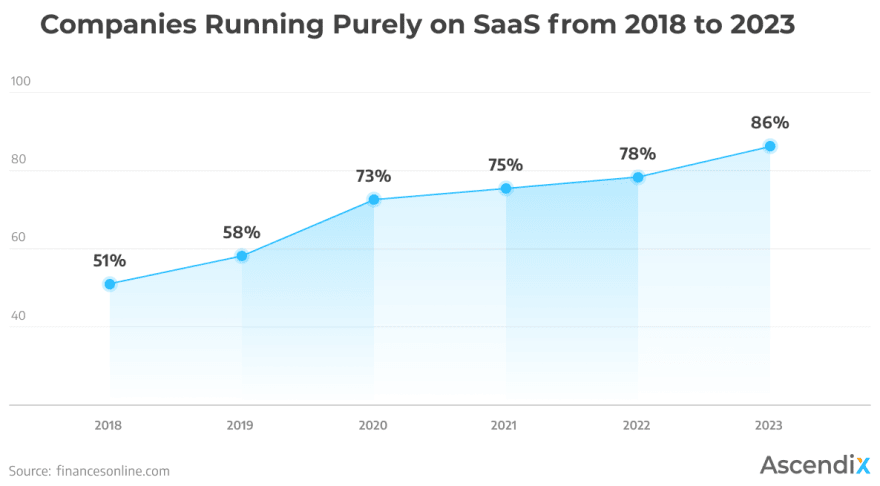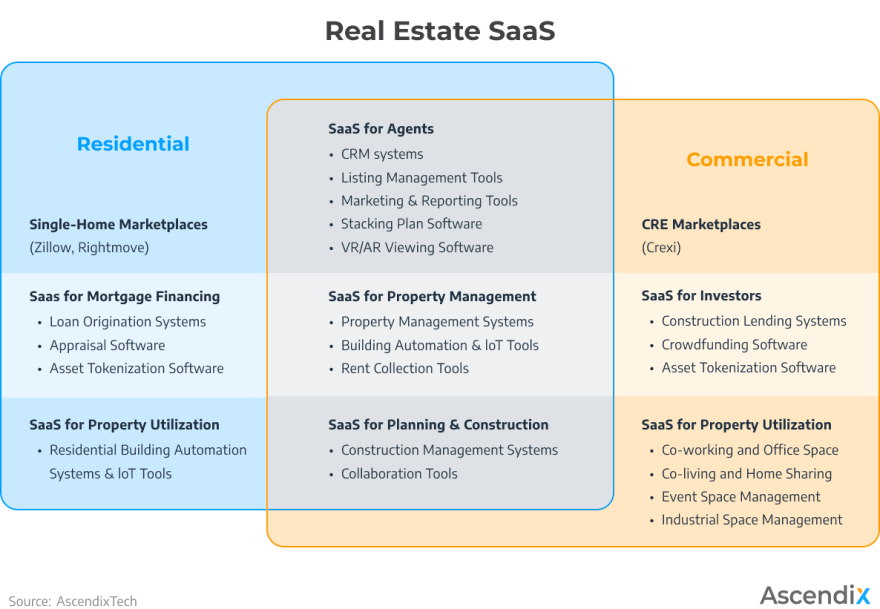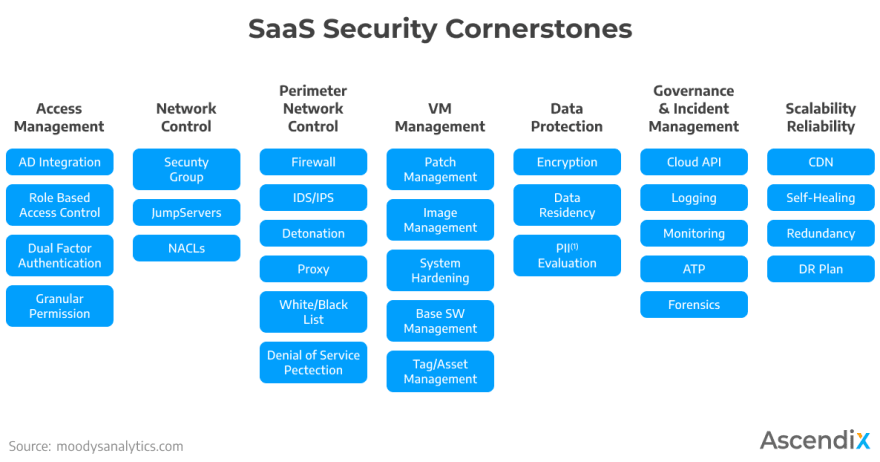With more and more real estate companies turning to software to automate processes and streamline operations, Proptech SaaS companies like Buildout and Zillow are gaining momentum.
And if in some industries you will not surprise anybody with a cloud-based app delivered over the Internet, in real estate – untouched by technological innovation for decades – the full potential of SaaS Proptech is yet to be unveiled.
Having operated at the juncture of proptech and SaaS for more than a decade, we have authored 17 real estate SaaS products and overseen numerous custom SaaS development projects and are ready to provide you with some key takeaways and lessons learned on how to successfully develop SaaS for real estate.
What is SaaS?
SaaS is an acronym for Software-as-a-Service – a subscription-based software distribution model in which a cloud provider delivers a ready-to-use solution to its customers via browser or mobile app with no installation needed.
To assess the service, users simply pay a fixed “rent” fee usually monthly or annually according to a chosen subscription plan, while software updates and system maintenance is a sole responsibility of the SaaS provider. All customer data and the software itself are stored remotely on a provider’s servers, commonly referred to as “cloud.”
In a nutshell, SaaS is software you don’t own but simply use for a time, pretty much like Uber for ordering a taxi or Canva for designing visual content.
How Does SaaS Work?
Multi tenancy model. The provider delivers one software instance to multiple customers (tenants) at a time, allowing them to customize some parts of the application, such as the color of the user interface (UI) or business rules but not the application’s code.
Cloud computing. The provider delivers the software over the Internet at the flat rate / per user / per storage / pay as you go pricing (see below). So, instead of buying, owning, and maintaining physical data centers and servers, customers can just pay a “rent” fee and access technology services when they need them.
Pricing model. The most common monetization model for all SaaS products and proptech SaaS in particular is flat rate pricing, when users pay a fixed fee for a defined set of features, but there are more pricing options out there:
- Per-Storage Model – charge fees depend on the amount of storage space users need. Among the top SaaS per-storage model companies are Sync, Google Drive, and OneDrive.
- Per-User Model – customers are charged depending on how many people are going to use the app (Slack).
- Pay as You Go – also known as usage-based pricing, pay as you go model means that the more customers use, the higher the charges (Chargify, ConvertKit, and SendGrid).
Is SaaS Going to Displace On-Premises Software?
Oh yes. For better or worse, the world hasn’t seen a single on-premises software company founded since 2007 (source), so, you might well call traditional systems that live exclusively on our hardware nearly extinct species.
And just looking at the staggering numbers of SaaS companies flooding the technology market, one thing is crystal clear: SaaS is the new normal of software development and distribution, and it doesn’t go anywhere soon.
But don’t just take my word for it. The graph below shows that companies are slowly but surely drifting to the cloud, more and more often relying on Software-as-a-Service solutions as their core technology choice.
Today the number of firms using SaaS stands at 78%, but considering the dizzying pace of how quickly cloud computing penetrated the major business spheres, it will be a small surprise if this estimate will reach 100% in several years.
The Benefits of SaaS for Real Estate vs On-Premises Software
The real estate industry has long been known for its loyalty to legacy systems and primitive productivity tools like Excel and Outlook, dating back to the first wave of CRE technology innovations.
This outdated technology has not only hindered the digital transformation of real estate for years but also is costly to maintain, upgrade, and scale. Unfortunately, this list only goes on.
A few viable options for the industry would be to migrate old systems to the cloud or abandon them completely and seek salvation in proptech SaaS solutions.
Either way presents a myriad of benefits and fresh opportunities for key stakeholders of a brand-new SaaS proptech app.
Speed of Implementation
Part of the beauty of software as a service is that it’s easy to get started. Since proptech SaaS solutions are already installed and configured, customers just choose a subscription plan they like, and they are good to go, with no system downtime or expensive technology setup.
No Excessive Upfront Payments
Whether it be a flat rate or “pay as you go” usage fees, customers have much more freedom in terms of how they spend their money. They can buy a subscription for a period and functionality they need and cancel it when they no longer need the service.
Cost, just like the speed of implementation, are the most lucrative benefits proptech SaaS companies market to real estate agencies as the latter tend to be cautious about making big upfront payments and would rather pay less for a partial improvement than making a huge one-time investment and suffering major system downtime.
Effortless Maintenance and Upgrades
Another advantage of real estate SaaS products highly valued by real estate agencies, which typically don’t have in-house IT personnel, is that they don’t have to worry about technical matters as seamless upgrades and system maintenance are already included in their ongoing subscription charge. On top of that, in case of any performance issues, the SaaS proptech provider will be there to help, again, at no extra charge.
Elastic Scaling Up and Scaling Down
The multi-tenant architectures most real estate SaaS software is built on can scale elastically to meet customer demands. You can add as many users as you want and expand your feature set to keep up with your business growth – and you only pay for what you use.
Examples of Real Estate SaaS Products
Accounting for $33.6 trillion in the US alone, real estate is the biggest industry globally with multiple facets like construction, brokerage services, real estate transactions, each having domain-specific issues and headaches. Multiply this by the number of real estate stakeholders (buyers, sellers, renters, landlords, etc.), and you’ll arrive at an estimate of how many real estate SaaS companies and solutions could be there.
The good news is they are not there yet. So, there is a lot of low-hanging fruit for those who decide to embark on efforts to build a disruptive proptech SaaS solution.
To start with, there may be commercial real estate SaaS software addressing the needs of the main CRE players (investors, renters, appraisers, real estate agents, etc.) revolving around commercial real estate (office spaces, industrial properties, multi-family, etc.); and residential proptech SaaS solutions for residential property stakeholders (renters, landlords, real estate agents, etc.) buying, selling, representing, and managing residential physical spaces (single-family houses, apartments, townhouses, etc.).
Real estate agent Saas, property management SaaS, and planning & construction SaaS can cater to both domains – residential and commercial.
Proptech SaaS CRM Systems
CRM stands for Customer Relationship Management platforms that are designed to integrate all business processes, from prospecting to deal closing, into one system, thus improving team collaboration and the company’s data aggregation. The best real estate SaaS CRM systems are Apto, Buildout, and AscendixRE, all built on Salesforce – the world’s biggest CRM SaaS provider.
Listing Management Tools
These tools help real estate agents to create and maintain property records and listing websites. Listing Management solutions easily integrate with the existing CRM system to automatically pull the minutest details, such as property type, property address details, a property built year, property interior and exterior features, and amenities of the property.
Construction Management Systems
These are cloud-based real estate SaaS platforms that seamlessly connect builders, designers, developers, engineers, and tradespeople throughout a construction project, ensuring adherence to budgets, sustainability principles, and performance requirements (Built, Procore, Buildertrend).
What We’ve Learned When Building Proptech SaaS
Real Estate SaaS Lives and Dies on User Experience
While this is true for almost all SaaS applications, real estate SaaS users may be especially picky toward the solution they’re going to invest a huge amount of money in. And don’t be tricked by the fact that real estate customers have long been underserved by technology – they will still want their applications to look pretty and straightforward. This is mainly because:
- Real estate professionals often don’t have large budgets for technology upgrades, so each penny they spend should be worth it.
- SaaS real estate, whether it be CRM systems or simple productivity tools, is going to be something that your target users will constantly use. And considering how hectic real estate workflows may get, your real estate SaaS product should be ready to ease those tasks with a simple and straightforward user experience.
Security First
As your end-users are going to work with sensitive information, like credit bank details, transactions, etc., your proptech SaaS solution should comply with the below SaaS-specific security requirements (source):
- Access Management. The SaaS proptech provider must provide a unified framework to manage user authentication through business rules that determine appropriate user access based on organizational role, the system accessed, the data requirements, and workflow assignments, independently of the device used.
- Network Control. Security groups control who can access specific instances of the real estate SaaS product across the network. For more granular control, this can also include jump servers and network access control lists (NACL).
- Perimeter Network Control. Perimeter defense has traditionally been about controlling traffic flowing into and out of a data center network. The primary technology that underpins perimeter protection is a firewall, which filters out potentially dangerous or unknown traffic that might constitute a threat based on a set of rules about the types of traffic and permitted source/destination addresses on the network. Most SaaS providers for real estate also deploy further levels of perimeter protection such as intrusion detection and prevention systems (IDS/IPS), which look for suspicious traffic after it has passed through the firewall.
- VM Management. Ensuring your proptech SaaS infrastructure is secure requires frequent updates directly to your virtual machine. Staying up to date requires a significant investment in ways to identify the latest threats and patches available in the market. A SaaS provider continuously performs these tasks on standardized VM images, and third parties used in its software. Therefore, the time between a breach and the resulting patch is reduced.
- Data Protection. The most important practice of all is the SaaS real estate provider’s methodology for preventing a data breach, primarily by using various methods for data encryption both at rest and in transit. Best practice solutions offer customers the option to control their encryption keys so that cloud operations staff cannot decrypt customer data. They also deploy encryption technology for data at rest, which provides options for building a hierarchy of client-side and server-side encryption for a high level of security, with separation of duty at the various levels of the hierarchy, customer control, and full audit trails. All this becomes more important with the stringent safeguards required for personally identifiable information (PII).
- Governance and Incident Management. Certain types of incidents must be captured, reported, and tracked to closure, and there must be procedures in place for investigating any potential security breaches.
- Scalability & Reliability. One of the biggest features of the cloud is the ability to increase capacity of existing hardware or software by adding resources as and when needed. Vertical scaling is limited by only being able to get as large as the size of the server. Horizontal scaling means the ability to connect multiple hardware or software entities, such as servers, so that they work as a single logical unit. This kind of scale, however, cannot be implemented at a moment’s notice, so a proptech SaaS solution vendor must build a considerable amount of horizontal redundancy into the infrastructure to ensure continuity of service. Finally, there must be a disaster recovery (DR) plan in place for replicating data and services in the event of a natural or human-induced regional disaster.











Top comments (2)
Building a Successful Proptech SaaS: An Inside Look at Real Estate Software Development provides a comprehensive and insightful look into the complexities of creating effective real estate software. The article breaks down each phase of development, offering valuable tips and strategies that can guide anyone interested in this field. It even touches on essential tools like Viewer bots to boost engagement and user interaction, which are vital for maintaining a competitive edge in today’s market. I particularly appreciated how the piece blends technical details with real-world examples, making it both informative and practical for aspiring developers and industry professionals.
Navigating the intricate landscape of Proptech SaaS demands a strategic approach to real estate software development. The insightful article delves into the intricacies, emphasizing the need for innovation and user-centric design. In this ever-evolving sector, staying ahead means embracing cutting-edge technologies. These Novo apartments, a rising player in the industry, exemplifies this ethos with its seamless integration of advanced features. As the article articulates the challenges and triumphs of building successful software, Novo apartments serves as a beacon, showcasing how forward-thinking solutions elevate the real estate tech game. A must-read for those steering the course of Proptech development.